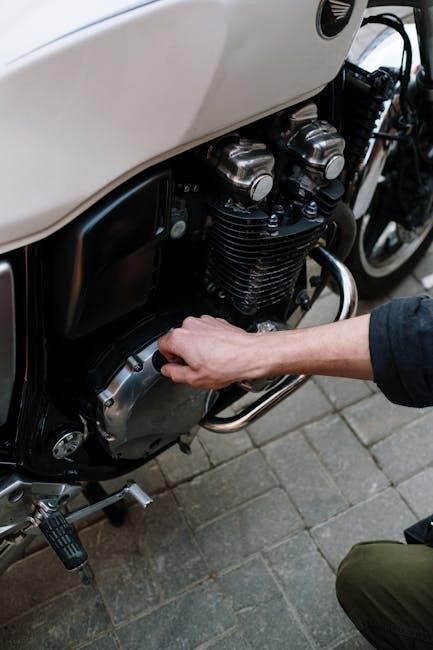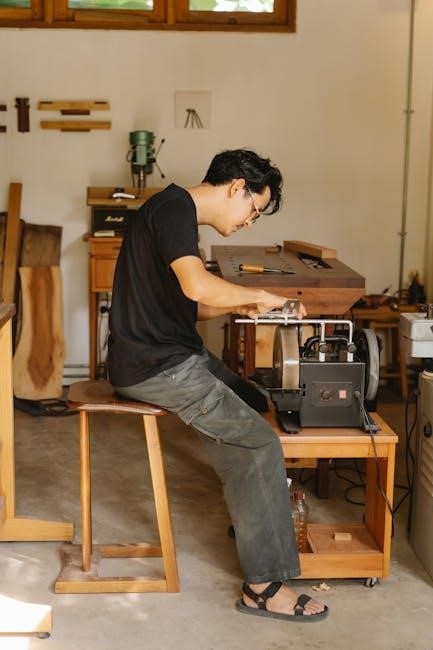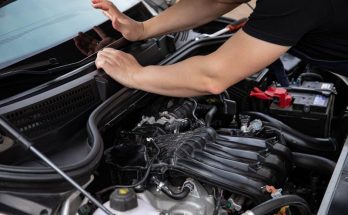Manual CNC machines blend traditional machining techniques with computerized control, offering precise operation and flexibility. They are essential in manufacturing for their adaptability, ease of use, and ability to handle complex tasks without extensive programming.
These machines are particularly valued in precision engineering and prototyping, where manual intervention is crucial for custom adjustments and small-batch production, making them a versatile tool in modern workshops.

What is a Manual CNC Machine?
A manual CNC machine is a type of computer numerical control machine that allows for hands-on operation, combining traditional machining techniques with computerized control. It enables precise movements and adjustments, making it ideal for intricate tasks. Unlike fully automated CNC machines, manual CNC machines require operator input for positioning and execution, often through jog wheels or manual data input. This blend of manual control and CNC technology provides flexibility, especially in small-batch production or prototyping. Operators can make real-time adjustments, ensuring high accuracy and adaptability. These machines are widely used in workshops and manufacturing facilities where customization and precision are critical.
Manual CNC machines are versatile tools that bridge the gap between traditional machining and advanced automation, offering ease of use and reliable performance for various applications.
Importance of Manual CNC Machines in Modern Manufacturing
Manual CNC machines play a vital role in modern manufacturing by offering precision, flexibility, and cost-effectiveness. They enable operators to make real-time adjustments, ensuring high accuracy in production processes. These machines are particularly valuable in industries requiring intricate customizations, such as aerospace and automotive manufacturing. Their ability to handle small-batch production and prototyping efficiently makes them indispensable in maintaining production agility.
Additionally, manual CNC machines are cost-effective for small to medium-sized manufacturers, as they combine the benefits of CNC technology with the adaptability of manual control. This hybrid approach allows for minimized material waste and optimized production workflows, making them a cornerstone in modern manufacturing strategies.

History and Evolution of CNC Machines
Manual CNC machines trace their origins to early machining tools, evolving from mechanical systems to computerized control by the 1940s, revolutionizing manufacturing efficiency and precision.
From Manual Machining to CNC Technology
The transition from manual machining to CNC technology marked a significant leap in manufacturing, driven by the need for greater precision and efficiency. Manual machining relied heavily on skilled operators, often resulting in variability and inefficiency. With the advent of CNC (Computer Numerical Control), machines began utilizing programmed instructions to execute tasks with minimal human intervention. This shift reduced errors and increased production speed, making it ideal for complex and repetitive operations. CNC technology integrated seamlessly with manual systems, creating hybrid machines that combined the best of both worlds. These machines allowed for precise control while still enabling manual adjustments, catering to industries requiring both automation and customization, such as prototyping and small-batch production.
Key Milestones in the Development of CNC Machines
CNC machines have evolved significantly since their inception, marking pivotal moments in manufacturing history. The first CNC machines emerged in the 1940s and 1950s, utilizing punched tape for programming. The 1960s saw the introduction of the first commercially available CNC machine, revolutionizing production processes. In the 1980s, the integration of microprocessors and CAD/CAM software enhanced precision and efficiency. The 1990s and 2000s brought advancements in automation and connectivity, with CNC machines incorporating IoT capabilities and advanced control systems. These milestones transformed manual machining into a high-tech industry, enabling faster and more accurate production while maintaining the versatility of manual adjustments for specialized tasks.

Basic Components of a Manual CNC Machine
A manual CNC machine consists of hardware components like motors, controllers, and sensors, along with software for programming and control, ensuring precise and efficient operation.
Hardware Components: Motors, Controllers, and Sensors
Manual CNC machines rely on robust hardware components to function effectively. Motors, typically stepper or servo, drive the axes with precision, ensuring accurate movement. Controllers, such as Mach3, interpret G-code and command the motors. Sensors play a crucial role in monitoring position, temperature, and operational safety, providing real-time feedback to the control system. Together, these components ensure smooth operation, enabling manual mode jogging and precise positioning. They form the backbone of the machine’s functionality, allowing for hands-on control and integration with software for seamless performance. Regular maintenance of these hardware elements is essential to maintain accuracy and longevity. Proper alignment and calibration are also vital for optimal operation.
Software Components: Programming and Control Systems
The software components of manual CNC machines are integral to their operation. Programming is typically done using G-code, which instructs the machine on specific tasks. Control systems, such as Mach3, interpret this code and execute commands. These systems offer features like Manual Data Input (MDI) mode, allowing operators to input commands directly. The software also enables real-time adjustments, crucial for manual control. Advanced interfaces simplify programming and operation, making it accessible for both novice and experienced users. Regular software updates enhance functionality and compatibility, ensuring optimal performance. The integration of programming and control systems allows for precise, efficient, and adaptable machining, making manual CNC machines indispensable in various manufacturing environments. Their versatility and ease of use contribute significantly to modern production processes;

Operating Modes of CNC Machines
Manual CNC machines operate in modes like Manual, MDI, and Single Block, offering flexibility for hands-on control, direct input, and step-by-step execution, enhancing machining precision and efficiency;
Manual Mode: Hands-On Control
In manual mode, CNC machines allow operators to control movements directly using handwheels or joysticks. This mode is ideal for setup tasks, positioning, and precise adjustments without complex programming.
Operators can move axes individually, making it easier to align tools or workpieces. Manual mode also enables testing and fine-tuning of operations, providing a hands-on approach for experienced machinists to ensure accuracy and safety.
It is particularly useful in scenarios requiring immediate adjustments, offering a straightforward method to achieve exact positioning and maintain production efficiency without relying on automated sequences.
MDI (Manual Data Input) Mode
MDI (Manual Data Input) mode allows operators to input specific commands directly into the CNC machine’s control panel. This mode is useful for executing single-line instructions or testing small segments of code without running an entire program.
In MDI mode, machinists can manually enter G-codes or M-codes to perform precise, one-off operations. It is particularly handy for quick adjustments, tool setting, or running small batches of parts. Operators can also use MDI to verify program logic before switching to automated modes.
This mode provides a balance between manual control and CNC precision, making it an essential tool for workshops requiring flexibility and immediate execution of specific tasks.
Single Block Mode
Single Block Mode is an operational feature of CNC machines where the machine executes one block of code at a time. This mode is particularly useful for testing and debugging CNC programs.
By running each line of code individually, operators can identify errors or inconsistencies in the program. It allows for precise control, enabling adjustments to be made before proceeding to the next block.
This mode is ideal for novice machinists or when working with complex programs, as it minimizes the risk of errors propagating through the entire operation. Single Block Mode ensures accuracy and safety in CNC machining processes.

Safety and Best Practices
Always wear safety glasses, secure the workpiece, and avoid loose clothing. Follow proper start-up and shutdown procedures to ensure safe operation.
Safety Precautions When Operating Manual CNC Machines
Operating manual CNC machines requires strict adherence to safety protocols to prevent accidents. Always wear protective gear, including safety glasses and gloves, to safeguard against flying debris. Ensure the workpiece is securely clamped to avoid movement during operation. Keep loose clothing or long hair tied back to prevent entanglement with moving parts. Follow proper start-up and shutdown procedures, and never leave the machine unattended while it is running. Be aware of your surroundings and maintain a clean workspace to reduce tripping hazards. Familiarize yourself with emergency stop procedures and use them if necessary. Regular maintenance is crucial to ensure all components function correctly, minimizing risks of mechanical failure. Proper training and understanding of manual controls are essential for safe operation.
Best Practices for Maintaining Manual CNC Machines
Regular maintenance is essential for ensuring the optimal performance and longevity of manual CNC machines. Start by lubricating moving parts to reduce friction and wear. Clean the machine thoroughly after each use to remove dust and debris, which can interfere with precision. Check and replace worn or damaged components, such as belts or bearings, promptly to prevent breakdowns. Schedule routine calibration to maintain accuracy and alignment. Keep the control system updated with the latest software to enhance functionality and security. Train operators on proper handling and maintenance techniques to avoid misuse. Document maintenance activities and perform thorough inspections before and after extended periods of inactivity. Consistent care ensures reliable operation and minimizes downtime, safeguarding your investment in these critical tools.

Maintenance and Troubleshooting
Regular lubrication of moving parts and thorough cleaning are vital. Check for wear on components like belts and bearings, replacing them when necessary. Consistent maintenance ensures smooth operation and helps identify issues early, reducing downtime and extending machine lifespan.
Regular Maintenance Tasks
Regular maintenance is crucial for optimal performance of manual CNC machines. This includes lubricating moving parts, cleaning the machine thoroughly, and inspecting belts and bearings for wear. Operators should also check the spindle and tool holders for alignment and tightness, ensuring all components are secure. Additionally, the coolant system must be monitored and refilled as needed to prevent overheating. Electrical connections should be inspected for wear or damage, and any loose wires tightened. Routine software updates are also essential to keep the control system functioning smoothly. By adhering to these tasks, operators can prevent unexpected breakdowns and extend the machine’s lifespan.
Common Issues and How to Fix Them
Manual CNC machines can encounter issues such as misalignment, mechanical component wear, and software glitches. Misalignment often occurs due to improper setup or wear on moving parts. To address this, operators should recalibrate the machine and ensure all components are securely fastened. Mechanical wear, such as worn-out belts or bearings, requires timely replacement to maintain precision. Software-related problems, like incorrect G-code or outdated firmware, can be resolved by updating the control system or reprogramming the task. Regular lubrication of moving parts and thorough cleaning of the machine can prevent many of these issues. Additionally, checking for loose connections and ensuring proper coolant flow is essential for smooth operation. Always consult the machine manual for specific troubleshooting steps and seek professional assistance for persistent problems.

Manual vs. CNC Operation
Manual CNC machines offer hands-on control for precision and customization, ideal for small batches and prototyping, while CNC operation provides automation, speed, and consistency, better suited for large-scale production.
Advantages of Manual CNC Machines
Manual CNC machines offer precision, flexibility, and cost-effectiveness, making them ideal for small-scale production and prototyping. They allow for hands-on control, enabling operators to make real-time adjustments, which is particularly useful for complex or custom projects. These machines are also more accessible for businesses with limited budgets, as they require less sophisticated programming and setup compared to fully automated CNC systems. Additionally, manual CNC machines foster skill development, as operators gain hands-on experience with machining processes. Their versatility and ability to handle unique tasks make them a valuable asset in workshops and manufacturing environments where customization and adaptability are prioritized.
Disadvantages and Limitations
Manual CNC machines have several drawbacks, including the need for continuous operator involvement, which can lead to fatigue and human error. Their reliance on manual input slows down production, making them less efficient for large-scale manufacturing compared to fully automated systems. Additionally, manual CNC machines often lack advanced features like automatic tool changers and high-speed machining capabilities, limiting their capacity for complex, high-volume tasks. Maintenance and setup can also be time-consuming, requiring skilled personnel. Furthermore, manual operation may result in variability in product quality due to the dependence on the operator’s expertise and attention to detail. These limitations make manual CNC machines less suitable for industries requiring high-speed, consistent, and large-scale production outputs.

Applications of Manual CNC Machines
Manual CNC machines are widely used in precision engineering, prototyping, and small-batch production for their adaptability and ability to perform intricate tasks with minimal programming, ensuring high accuracy and customization in manufacturing processes.
Use in Precision Engineering
Manual CNC machines are indispensable in precision engineering due to their ability to handle intricate designs and tight tolerances. Their manual mode allows operators to make precise adjustments, ensuring high accuracy in complex components. This is particularly beneficial in industries requiring custom parts, such as aerospace and medical devices. The machines’ adaptability enables engineers to fine-tune operations, making them ideal for projects where human expertise is crucial. Additionally, the integration of manual control with CNC technology ensures that even the smallest details are executed flawlessly, maintaining the highest standards of quality and reliability in precision engineering applications.
Role in Prototyping and Small-Batch Production
Manual CNC machines play a vital role in prototyping and small-batch production due to their flexibility and customization capabilities. They allow for quick design iterations and precise adjustments, making them ideal for creating prototypes that require frequent modifications. In small-batch production, these machines enable manufacturers to produce limited quantities efficiently without the need for extensive programming or setup. Their manual mode ensures that operators can make real-time adjustments, which is crucial for unique or complex designs. This adaptability makes manual CNC machines a cost-effective solution for businesses needing to test concepts or produce specialized parts in low volumes, ensuring high-quality outcomes without compromising on time or resources.
By combining manual control with CNC precision, these machines bridge the gap between traditional craftsmanship and modern manufacturing, making them indispensable in rapid prototyping and small-scale production environments.

Future Trends in Manual CNC Technology
The future of manual CNC machines lies in integration with advanced automation, AI, and IoT. Enhancing precision and efficiency through smart technologies while maintaining manual control for optimal manufacturing outcomes.
Integration with Advanced Automation
The integration of manual CNC machines with advanced automation technologies is revolutionizing manufacturing processes. By incorporating AI and IoT, these machines can optimize production workflows, predict maintenance needs, and enhance precision. Automation enables seamless communication between manual controls and digital systems, reducing human error and increasing efficiency. This blend allows operators to leverage the benefits of automation while retaining hands-on control for complex tasks. Such advancements ensure that manual CNC machines remain competitive in the evolving industrial landscape, offering a balanced approach between traditional craftsmanship and cutting-edge technology.
Emerging Technologies in Manual CNC Machines
Emerging technologies are transforming manual CNC machines, enhancing their capabilities and efficiency. Innovations like AI-optimized controls and smart interfaces enable operators to achieve higher precision with minimal effort. Real-time monitoring systems now allow for predictive maintenance, reducing downtime and improving overall productivity. Additionally, advancements in machine learning are being integrated to assist operators in optimizing cutting paths and tool usage. These technologies not only streamline operations but also ensure that manual CNC machines remain relevant in the era of smart manufacturing, offering a perfect blend of traditional craftsmanship and modern innovation.
Manual CNC machines remain essential in manufacturing, bridging traditional machining with modern technology. They excel in precision engineering and small-batch production, offering adaptability and ease of use for diverse tasks.
Manual CNC machines combine traditional machining with computerized control, offering precision and adaptability. They are crucial in modern manufacturing for tasks requiring both manual intervention and automated processes. These machines operate in modes like manual, MDI, and single block, allowing flexible control. Regular maintenance and adherence to safety protocols are essential for optimal performance. While they lack the full automation of CNC machines, manual CNC machines excel in prototyping and small-batch production, where customization is key. Their integration with emerging technologies promises further advancements, ensuring their continued relevance in manufacturing. Understanding their operation, maintenance, and applications highlights their importance in bridging manual craftsmanship with modern industrial needs.
Final Thoughts on the Importance of Manual CNC Machines
Manual CNC machines remain indispensable in modern manufacturing, bridging the gap between traditional craftsmanship and advanced automation. Their ability to combine manual control with precise computerized operations makes them invaluable for intricate tasks and small-scale production. While fully automated CNC machines offer speed, manual CNC machines provide the flexibility and customization needed for complex projects. Proper maintenance, skilled operation, and adherence to safety protocols ensure their longevity and efficiency. As technology evolves, integrating manual CNC machines with emerging tools promises enhanced productivity. Their role in precision engineering and prototyping underscores their continued relevance. Embracing manual CNC machines allows manufacturers to balance tradition with innovation, ensuring adaptability in a rapidly changing industrial landscape.



